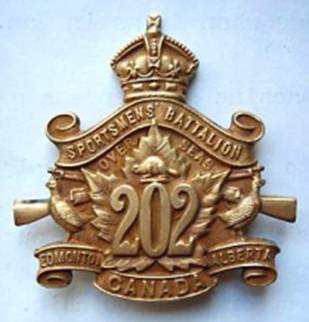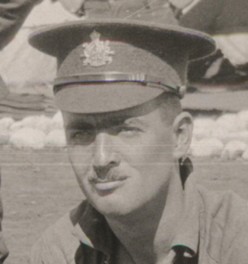202nd Overseas (Sportsman's) Battalion CEF
Canadian Expeditionary Force
Edmonton Alberta Canada
The 202nd (Sportsmen's) Battalion, CEF was a unit of the Canadian Expeditionary Force during the First World War.
Based in Edmonton, Alberta, this unit began recruiting from the districts
of Victoria and Battle River during the winter of 1916, after Lieut-Col.
Peter Edwin. Bowen was granted the authority to do so on 5th February
1916.
Battalion Headquarters was Edmonton South.
Training was taken at Camp Sarcee between, June 1916 until October 1916.
After later sailing to England in November 1916, the battalion was absorbed
into the 9th Reserve Battalion on May 28, 1917.
The 202nd (Sportsmen's) Battalion, CEF had one Officer Commanding: Lieut-Col.
Peter Edwin Bowen
Most likely Composition of the 202nd Infantry Battalion as guided by the
Army at the time was as below.
On the outbreak of the First World War, a battalion at full War establishment
was comprised of 1,107 officers and men. Commanded by a Lieutenant Colonel,
it had a Headquarters, Machine Gun section and four Companies.
The Headquarters was made up of the Commanding Officer, his Second in Command, an Adjutant (a kind of 'battalion staff officer'), the Quartermaster, plus the Orderly Room staff, Pioneers, Signallers, and Stretcher Bearers. There would also be a Medical Officer and a Padre. The Medical Officer might have some attachments from the Royal Army Medical Corps, and there would also be an Armourer from the Army Ordnance Corps. In total there were 4 officers, 1 Warrant Officer (the Regimental Sergeant Major), eight Sergeants and 61 Other Ranks; plus the Medical Officer and the Padre, and a Transport Officer if one had been appointed.
The Machine Gun Section had two Guns, and was commanded by a Second Lieutenant or a Lieutenant. He had one Sergeant and sixteen men under his command. In the 202s' case the Lieutenant was T. H. Gilman and his sergeant was the famous later RAF ace Wilfred Reid "Wop" May ... Machine Gun Section at Sarcee camp photo ... Witley Camp "C" Coy Photo
Each Company in the battalion were normally lettered from A to D,
and was commanded by a Major or Captain. He had a Second in Command, normally
a Captain. There was also a Company Sergeant Major, and a Company Quarter
Master Sergeant. In total there were normally up to 227 officers and men
in a Company.
Each Company was split into four Platoons, each one numbered. Nos
1 - 4 always served in A Company, Nos 5 - 8 in B Company, Nos 9 - 12 in
C Company, and Nos 13 - 16 in D Company. The composition of a Platoon
was 1 officer, 8 Sergeants, 10 Corporals, 4 Drummers, 4 Batmen and 188
Privates.
Each Platoon was commanded by a Second Lieutenant or a Lieutenant, with
a Platoon Sergeant as his right hand man. His Platoon was made up of four
Sections, of twelve men, each commanded by a Non Commission Officer (NCO)
- usually a Corporal.
Later the 202nd Battalion were absorbed into the 13th Canadian Infantry Brigade which was established as part of the 5th Canadian Division in England in November 1916. The brigade was composed of the 128th battalion from Saskatchewan, the 134th and 160th Battalions from Ontario and the 202nd Battalion from Edmonton. The brigade was commanded by Brigadier-Generals J.F.L. Embury and A.E. Swift and Lieutenant-Colonel R.G.E. Leckie.*1
War Changes to the Battalion
As the war progressed the strength of a battalion varied greatly as men
became casualties, went sick or were transferred. Heavy losses throughout
the war meant that by the time of the Battle of Passchendaele in 1917,
the average infantry Battalion was around 450 officers and men; less than
half its pre-war establishment. The Vickers was replaced at battalion
level by the Lewis light machine gun. Initially there were four in every
Battalion, in a Lewis Gun Section and commanded by Second Lieutenant or
a Lieutenant. Other changes included increasing the number of Stretcher
Bearers, particularly as casualties amongst this section were often very
high
This website is a private site set up and maintained by Adam Burns-Mace
the grandson of Wilfred Burns Mace (#231361) and is put together in the
memory of him as well as Wilfred's brother Thomas Burns Mace (#231818).
I have after a many years of discovering information on the 202nd Battalion,
along with many images connected to the battalion, started to put what
I have found onto the pages of this site and will continue to do so as
and when I can.
So my mission is to, not
only try and understand the life and times of these brave men after they
enlisted in the 202nd battalion but also try and put NAMES
to FACES to the serving officers and men. To this end with many hours
of research I have, to date and with the grateful help and support of
many others, managed to identify 162 plus officers and men so far
(May 2023) and this started with just two, one being my Grandfather.
So if you have a family member that served in the 202nd Battalion please
do let me know perhaps we can help each other..
If you have any information at all that is connected with this 202nd Battalion
please do contact me. I have received many emails from relatives which
are making my task much easier and will hopefully benefit future generations
to come so please contact me at 202@tudor-lichfield.co.uk
Please see my links below (at the bottom of this page) including a very hard to find photo of the whole battalion taken 14th October 1916 at Saree Camp Alberta Canada
Updated 12/05/2023
*1http://www.cefresearch.com/matrix/Army%20Corps/Divisions/5th%20Division/13th%20Infantry%20Brigade/160th%20Battalion.htm

Dedicated to the memory of my Grandfather
Wilfred Burns Mace (#231360).

Recruiting Poster for the 202nd.
from my private collection
